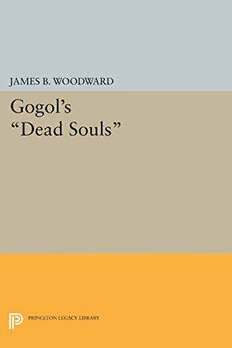
Gogol's "Dead Souls" PDF
Preview Gogol's "Dead Souls"
Gogol's Dead Souls James B. Woodward Gogol's Dead Souls PRINCETON UNIVERSITY PRESS Princeton, New Jersey Copyright ® 1978 by Princeton University Press Published by Princeton University Press, Princeton, New Jersey In the United Kingdom: Princeton University Press, Guildford, Surrey All rights reserved Library of Congress Cataloging in Publication Data will be found on the last printed page of this book Publication of this book has been aided by a grant from the Paul Mellon Fund of Princeton University Press This book has been composed in VIP Bembo Printed in the United States of America by Princeton University Press, Princeton, New Jersey Contents Preface vii Introduction ix 1 Sobakevich 3 2 Nozdryov 33 3 Manilov 52 4 Korobochka 70 5 Plyushkin 106 6 The Masters and the Slaves 138 7 The Masters and the Ladies 171 8 Forgeries of Fact and Counterfeit Truths 192 9 The "Paternal" Theme 215 10 Chichikov and Russia 230 Conclusion 252 Notes 257 Preface Alone of the great Russian novels of the nineteenth century Gogol's Dead Souls (Myortvyye dushi) remains nearly as pro found a mystery today as when it first appeared. With the possible exception of some of its author's shorter narratives, it is the most perplexing work of fiction in the Russian language—a work that appears to owe no significant debt to any literary tradition, to elude every attempt at an all- embracing interpretation, and to be explicable only as the bizarre creation of a bizarre personality. Virtually every impor tant aspect of the novel is still subject to sharply contrasting judgments, and even the term novel is applied to it with some hesitation, as Gogol emphatically called it an "epic poem lpoema]." In the present book an attempt is made to dispel some of the confusion by examining the fundamental question of how the first part of the projected three-part "epic"—the only part completed—functions as a work of art. The premise here, quite simply, is that the traditional view of the novel as a sprawling mass of loosely connected episodes, details, and digressions which often bear little perceptible relation to the plot (i.e. the story of the hero's adventures) is entirely misconceived and attributable to a failure to determine the nature of Gogol's creative method. The purpose of the book is to provide a new interpretation of the novel's meaning by tracing the essential features of this method and to show thereby that its structure is not only far more taut and disciplined than it appears, but also highly expressive. It is hoped that these conclusions will lay a sound foundation for future debate. VlIl PREFACE References to the novel are to the definitive version and early drafts contained in volume vi of the fourteen-volume edition of Gogol's works published by the Soviet Academy of Sciences,1 and page numbers are entered in the text. In references to the edition in footnotes the abbreviation PSS is used. Unless otherwise indicated, all translations from the Russian are my own and all dates are in "Old Style." J.B.W. Swansea November 1977 Introduction Art instills harmony and order into the soul, not confusion and disorder.—N. V. Gogol1 Strangely enough, the central theme of Dead Souls is one of the few aspects of the novel about which no serious dispute exists. The title of the work expresses it succinctly. It is true that the ambiguity of the noun dushi (which means "serfs" as well as "souls") raises the question of the importance to be attached in the novel to the social theme of serfdom and its evils, and that Western and Soviet critics differ sharply in their attitudes to this question, but no one presumably would disagree that from beginning to end the novel is primarily an expose of mortified souls. The major dispute concerns the manner in which this theme is developed, and the two extreme views on this subject as sociated with the names of Behnsky and Nabokov are suffi ciently well known to obviate the need for further lengthy summaries. It will suffice to reiterate that according to Be- linsky, from whom Soviet critics have almost unanimously taken their cue, the expose is achieved by means of a satirical portrayal of Russian life and society that is basically realistic in character, and Nabokov contends that the world ofDead Souls is essentially a creation of the author's fantasy designed to provide glimpses of the realiora—in his own phrase, "the shadows of other worlds"2—behind the facade of contingent realia.
